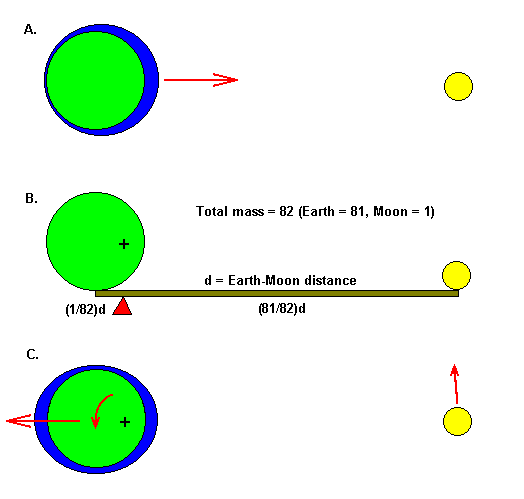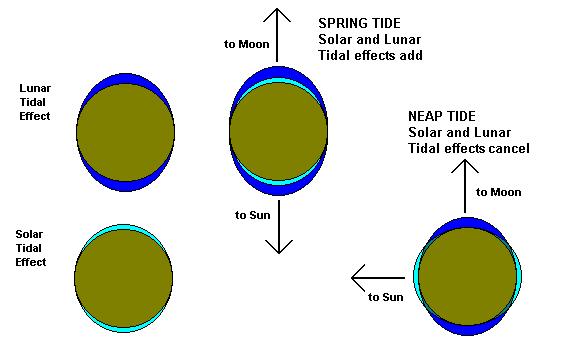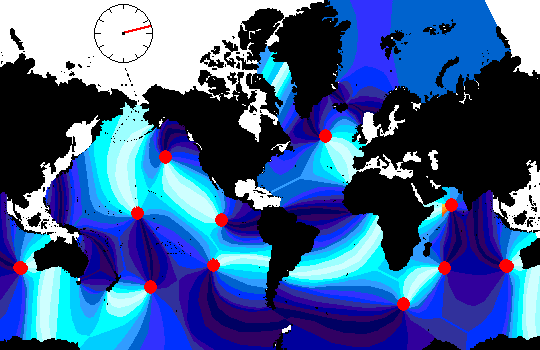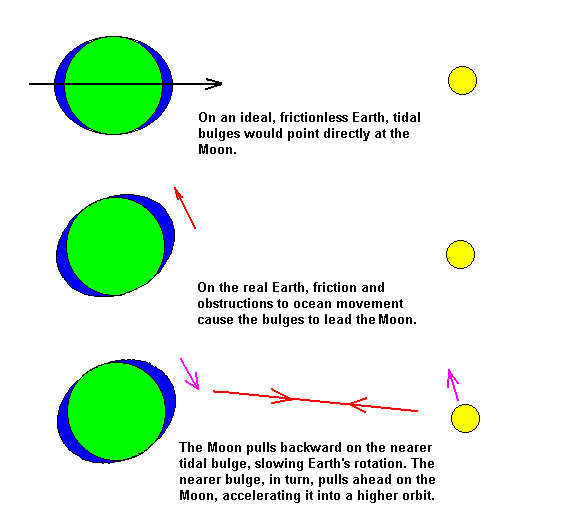The Oceans
Steven Dutch, Professor Emeritus, Natural and Applied Sciences, University of Wisconsin - Green Bay
Marine Geology
Sea Water
| Element | Weight %: 1%=10 gm/liter |
|---|---|
| Cl | 1.9 |
| Na | 1.05 |
| Mg | 0.135 |
| S | 0.0885 |
| Ca | 0.040 |
| K | 0.038 |
| Br | 0.0065 |
| C | 0.0028 |
| Sr | 0.00081 |
| B | 0..00096 |
| Si | 0.00030 |
| F | 0.00013 |
The oceans are very uniform in composition. The amount of dissolved material may vary due to evaporation or freezing, but the relative concentrations of dissolved materials are very constant.
Why the Sea is Salty
Recall that when we discussed the age of the earth, one early method for estimating the age of the earth was to compare the input of elements to the total amount already in the oceans. It turns out that if we do this for different elements we get wildly different results.
| Volume of Oceans | 1.4 x 1021 m3 |
| Annual Global Discharge of Rivers | 3.6 x 1016 m3/year |
| Filling Time | 4 x 104 years |
In other words, it would take rivers about 40,000 years to fill the ocean basins.
| Element | Concentration in rivers (ppm) | Concentration in oceans (ppm) | Time (years) |
| Chlorine | 7.8 | 19400 | 100 million years |
| Sodium | 6.3 | 10500 | 67 million years |
| Calcium | 15 | 411 | 1 million years |
| Silica | 13.1 | 3 | 9000 years |
| Aluminum | 0.4 | 0.001 | 100 years |
These figures are actually residence times, the average length of time an ion remains dissolved in the ocean. Aluminum is not very soluble in alkaline solutions like sea water and disappears very quickly. Calcium and silicon are taken out of solution by marine organisms and used to make shells, and also disappear quickly. Sodium and chlorine are removed by the fewest processes and build up in the oceans; that's why the sea is salty.
So residence times are minimum ages for the ocean. The ocean has to be at least as old as the longest residence time but could be (and is) far older. Early geologists realized that elements remain in the ocean for differing times and relied on sodium and chlorine. They also attempted to correct for processes that remove these elements.
Actually, oceanographers are interested in all the processes that add and remove elements from the oceans. Most chlorine is believed to have been added not by rivers but from submarine volcanic vents. Also, some of the ions in the ocean came in not as dissolved solids but attached to sediment particles. Also, a lot of the dissolved material in oceanic vents is recycled ocean water, and some dissolved material is carried onto the land as precipitation, as well. Taking those other factors into account, the residence time for chlorine is essentially infinite, sodium about 260 million years, calcium 8 million years.
Ocean Currents
The Coriolis Effect
Contrary to that award-winning science documentary The Simpsons, if you place a six-hour collect phone call to Australia, you will not discover that toilets flush in the opposite direction south of the equator. On the scale of a sink or bathtub the Coriolis Effect is tiny compared to other forces. Even after letting water stand for days, there can still be enough residual circulation to overwhelm the Coriolis Effect, and the mere act of pulling the plug can disturb the water even more.
The Coriolis Effect is the result of moving on a spherical rotating earth.
Imagine you and a friend are on a merry-go-round and you throw a ball to him. A perfectly straightforward task.

Except that it turns out not to be so straightforward. The ball travels a curving path and misses the mark.

An outside observer sees nothing odd at all. The ball did travel a straight line, but you and your friend were both moving in a circle. When you rotate, you experience odd effects we sometimes call "forces." "Centrifugal force" is one, the "Coriolis Force" is another. Neither exist to an observer standing still.

 |
Imagine two planes headed for Miami (purple). One is headed south from Toronto (green), the other north from Panama (red). |
 |
The earth's rotation means Miami is moving faster than Toronto but slower than Panama. If the planes don't correct somehow, the plane from Toronto will end up west of Miami and the Plane from Panama will end up east.
In reality this is not a problem for planes because the earth's rotation carries the atmosphere along with it. |
The Coriolis Effect causes things moving toward the poles to lead the earth's rotation because they are headed into regions where the earth's rotational speed is slower. They are deflected to the east.
The Coriolis Effect causes things moving toward the equator to lag the earth's rotation because they are headed into regions where the earth's rotational speed is faster. They are deflected to the west.
There's nothing magic about this variation in rotational velocity. Panama, Miami and Toronto travel in a circle every 24 hours. Toronto's is smallest so it moves slowest. Panama's is larger, so it moves faster.
If you understand why the Coriolis Effect works, you don't need to try to remember what moves clockwise or counterclockwise in what hemisphere. You can figure it out.
Ocean Circulation
Surface circulation is driven by the winds.


In detail, ocean currents are always changing. One of the most interesting tracking efforts involved a cargo ship that lost a container of athletic shoes. Oceanographers used reports of shoes washing ashore to refine their models of ocean currents. More recently a cargo of toys was used the same way. Oceanographers were literally tracking ocean currents by following the movements of rubber ducks.
Deep circulation is the result of dense, cold, salty water sinking, rising to merge with the surface circulation, then returning to the polar regions to sink again.

Tides
There are Two Tidal Bulges

- Moon's Gravity Pulls Oceans - Near-side Bulge is Easy to Understand
- Moon and Earth actually orbit around the Earth-Moon Center of Mass (about 1500 km beneath the surface of the Earth)
- Motion of Earth Around Center of Mass Creates a Bulge on the Far Side of the Earth
Both Moon and Sun Cause Tides

- Spring Tides
- New or Full Moon
- Sun and Moon Pulling in Parallel Directions
- Lunar and Solar Tides Add Up
- Unusually Large Tidal Range
- Neap Tides
- First or Last Quarter
- Sun and Moon Pulling At Right Angles
- Lunar and Solar Tides Partially Cancel
- Unusually Small Tidal Range
Tides Affect Earth's Rotation
 |
Tides in the oceans cannot move freely because of the continents. They actually flow in a complex manner as shown below. Most often they circulate around nodes, very much the way a wave rotates around a cup as you oscillate it. |
In narrow, parallel-sided bodies of water the tides move as waves, for example in the South Atlantic. The map below shows the position of high tide crests at three-hour intervals.



- Rotation and Friction Causes Tides to Lead Moon
- Bulge Pulls Moon, Throws into Larger Orbit
- Friction Slows Earth
- Precambrian (900 m.y.): Year = 500 Days, Day = 18 Hr., Month = 23.4 Days
- Cambrian (500 m.y.): Year = 400 Days, Day = 22 Hr.
Tidal Phenomena
- Range 0-50 Ft
- Tidal Bore
- Tidal Falls or Rapids
- Tidal Channels & Deltas
Tides and History
The Boston Tea Party, December 16, 1773
- Near Earth's perihelion: strong solar tides
- Near lunar perigee: strong lunar tides
- Full moon on December 13: spring tide
- Overall effect: unusually large tidal range
On December 16, 1773, American colonists, frustrated by British tax policies, planned a dramatic protest. The merchant ships Dartmouth, Endeavour, and Beaver were in port with a cargo of tea, on which the colonists refused to pay tax. Negotiations with British authorities had broken down that afternoon, and the cargo was due to be seized at midnight if the tax was not paid. A group of colonists, dressed as Indians (a disguise which fooled nobody) boarded the ships about 6 P.M. and threw the tea overboard in the famous Boston Tea Party. But what happened to the tea after that?
 |
Ideally, the tea should have been thrown overboard just after high tide, so the ebbing tide could carry it out to sea. In reality, because the colonists had only a few hours to stage their protest, they could not plan for the tides. The Boston Tea Party fell not just at low tide, but an exceptionally low tide at that. The incoming tide simply washed the tea ashore, and work parties with shovels cleaned it off the waterfront and threw it back into the harbor next day (pollution was not a concern for most people in those days!). |
The Battle of Tarawa, November 20, 1943
- Near Earth's perihelion: strong solar tides
- Near lunar apogee: weak lunar tides
- Near last-quarter moon: neap tide
- Overall effect: unusually small tidal range
 |
The effect of tides on the Boston Tea Party is a humorous footnote to history. The effect of tides on the battle for Tarawa during World War II was anything but. Tarawa was one of the easternmost Pacific islands held by the Japanese, and the assault was the first amphibious assault in the Pacific during World War II. Sketchy tide data for the island suggested a tidal range of about seven feet. However, there were puzzling rumors of periods when the tides on Tarawa almost ceased, a condition local mariners called a Adodging tide@. |
 |
Tarawa is a type example of an atoll, a flat-topped submarine mountain capped by coral. Most atolls, like Tarawa, have a wide shallow lagoon ringed by low coral islands.
The only island of consequence at Tarawa was one with an airfield. The plan was for Allied ships to stand offshore in deep water and send landing craft into the lagoon. The landing craft would go as far in as possible and discharge troops. |
The invasion was set for November 20, 1943 when tide conditions were expected to be favorable. At low tide in the early morning, the bombardment would begin. As the tide rose and water levels in the lagoon reached 1.5 meters (five feet), landing craft would head ashore and by noon, at high tide, heavier craft could come ashore bringing tanks and supplies.
This isn't the sort of thing you can call off and reschedule if things go wrong, as they did. Once an attack is under way, the enemy knows your intentions. Any delay merely gives the enemy time to reinforce or escape.
 |
Unfortunately, the rumors of almost-tideless periods at Tarawa were true. November 20 was near last-quarter moon, resulting in a neap tide. Military planners knew about the risks of neap tide but did not realize the moon was unusually far from earth as well, weakening its tidal effects even more. Also, the Earth was only seven weeks from perihelion, meaning solar tides were unusually strong as well.
The top diagram shows what planners expected. The bottom one shows what actually happened. |
Landing craft hit bottom hundreds of meters offshore and the Marines had to wade ashore under heavy fire. Once ashore, they had to fight without assistance, because supply ships could not come in. For 48 hours, the tidal range was only 60 centimeters (two feet), and it was four days before the tidal range increased to normal. 1027 Marines were killed and 2292 wounded in the battle.
Return to Earth Science Notes Index
Return to Physical Geology Notes Index
Access Slides on Coastal Erosion
Return to Professor Dutch's Home Page
Created 21 May 1997, Last Update